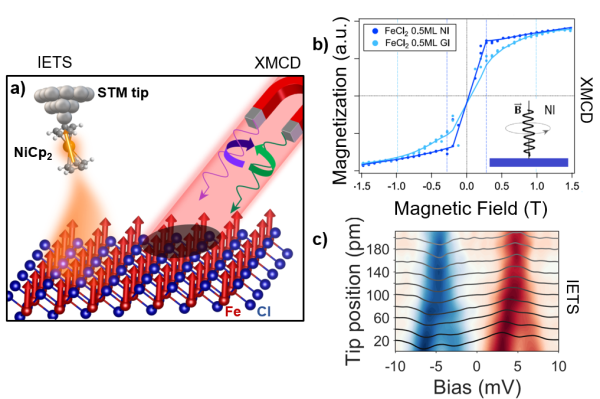Ferromagnetic Order in 2D Layers of Transition Metal Dichlorides
The fast increase of the family of magnetic two-dimensional materials led to the observation of different types of magnetic order in the 2D limit, as anti or ferromagnetism, non-collinear order or magnetic moiré effects. Here we demonstrate that the transition metals dichlorides FeCl2 and NiCl2 are soft ferromagnets. We explore the ferromagnetic order by surface sensitive techniques in ultra-high vacuum by combing averaging techniques as X-rays Magnetic Circular Dichroism (XMCD) with atomic scale scanning tunneling microscopy (STM). Decorating STM tips with a nickelocene molecule, we achieve high-resolution spin sensing due to exchange interactions between the molecule and the chlorides even at zero applied external magnetic field, thus demonstrating the effectiveness of combining both techniques to probe surface magnetism.

Figure. a) Experimental characterization of the ferromagnetic order at the single layer limit of van der Waals materials based on transition metal dichlorides. b) XMCD Magnetization loop measured at the L3 Fe edge for a submonolayer of FeCl2 grown on Au(111) at normal (NI) and grazing incidence (GI) at 3 K. Saturation is reached at NI before than at GI. The inset is a scheme of the incidence angle corresponding to the out-of-plane easy axis of magnetization direction for FeCl2. c) Inelastic tunneling spectroscopic measurement showing the second derivative conductance map taken by approaching a nickelocene molecule (NiCp2) on FeCl2 without external magnetic field applied. The splitting of the IETS peaks corresponds to the breaking of the degeneracy of the excited states of NiCp2 due to the presence of the effective magnetic field of FeCl2.
Transition metals dihalides are an ideal class of van der Waals layered materials that enable the study of magnetic phases as function of the transition metal and halide composition as predicted by theory. In this work, we characterize the magnetic and electronic properties of two-dimensional magnets based on metallic dichlorides. The materials can be epitaxially grown on the inert Au(111) surface in ultra-high vacuum and form flat layers electronically decoupled from the substrate. The materials are easily grown by thermal sublimation of molecular powders that lead to the formation of stoichiometric layers as confirmed by X-ray Photoelectron spectroscopy. Both materials exhibit semiconducting properties with a bandgap of about 4 eV. By synchrotron-based X-Ray Magnetic Circular Dichroism (XMCD) measurements we find that single layers of FeCl2 and NiCl2 are soft ferromagnets on Au(111) and their magnetization can be switched from out-of-plane to in-plane by substituting the metal ion from Fe to Ni. Using low temperature scanning tunneling microscopy (STM) with tips functionalized with a nickelocene molecule as magnetic sensor, we confirm the magnetic order of the materials at the atomic scale even at zero applied magnetic field. The spin-sensing is enabled by the exchange interaction occurring between the nickelocene and the metallic dichloride layer across the vacuum barrier that leads to changes in the spin excitation spectrum of nickelocene.
We thus established a correlation between the mesoscopic magnetic properties probed by XMCD and the atomic spins. Our results suggest that these 2D semiconducting magnets could be implemented in van der Waals heterostructures for applications in spintronics and opto-spintronics.



